Founded in 1992 by the Greek entrepreneur George Poulides, Festival Cruises got its start by using second-hand ships. The company was also known as First European Cruises throughout North America due to the similarity the Festival name has with Carnival Cruise Line. Throughout this article, we’re going to look at all of the ships that sailed with Festival Cruises and discover where they came from and where they are today. They began sailing with their first ship in 1994.
MS Azur
(1971-present, 1994-2004 with Festival Cruises, 14,717 GT, 770 Passengers & 325 Crew)
A subsidiary of P&O Ferries, Southern Ferries, launched the MV Eagle in 1971 as a car/cruise ferry featuring a six-day itinerary between Southampton, Lisbon and Tangier. The route proved to be unsuccessful and by 1975, the ship was sold to Paquet Cruises subsidiary Nouvelle Cie. de Paquebots. Upon the acquisition, her name was changed to Azur as she continued to perform cruise and ferry voyages in the Mediterranean. They held this model of operations until 1981 when Paquet rebuilt the ship into a full-time cruise ship, changing out her car decks into staterooms, plus a new pool was outfitted on her stern. By 1987, Azur was sold to the Greek cruise company, Chandris Lines.
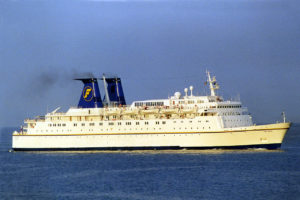
Upon entering service with Chandris’ subsidiary Chandris Fantasy Cruises, her name was once more changed to The Azur and her funnels were painted in the traditional Chandris blue with a white chi (“X“). 1994 saw a change in operations as Chandris was phasing out the Fantasy Cruises brand, which sparked the sale of The Azur to the newly formed Festival Cruises. She was home-ported in Venice and Genoa until the company filed for bankruptcy in 2004. The Azur was sold to Israel-based Mano Maritime for more than $10 million.
Her name was changed to Royal Iris and both sides of her hull received smiling yellow fish artwork. Her itinerary shifted to the Greek Islands and Cyprus until 2014 with Mano Cruises when they renamed her to Roy Star when she was laid up in Greece until 2017. She was then purchased by Black Sea Cruises, based in Sochi, which is Russian flagged and calls on ports in the Black Sea. This ship is still in operation.
MS Bolero
(1968 – 2018, 1995-2004 with Festival Cruises, 15,781 GT, 910 Passengers & 400 Crew)
Norwegian Caribbean line developed the Starward cruise ship as a sister ship to the Sunward, however during construction, they changed the design to exclude freight capacity and placed guest cabins in their spot. Starward sailed out of Miami in 1968 as the first Norwegian-flagged ship to meet American ‘Method 1’ fire-protection standards. This meant that there were non-combustible materials throughout passenger and crew accommodations.
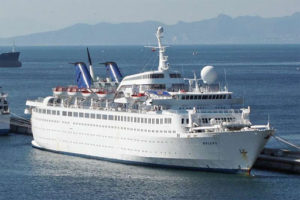
In 1995 Festival Cruises announced the purchase of Starward and indicated that the name would be changed to Bolero. By 2001, the ship was chartered to Spanish Cruise Line and following the collapse of Festival Cruises in 2004, Bolero was transferred to Cruises Elysia who quickly sold her to Abou Merhi Cruises and renamed her to Orient Queen. The following year, she was refitted with a new helicopter pad added onboard. Her new itinerary would sail from Beirut for six months. In 2005, she was repositioned to Dubai to attempt a Persian Gulf cruise program. Less than a year later, she was moved back to Beirut.
In 2006, the United States chartered the ship to assist with the evacuation of US citizens form Lebanon due to the ongoing conflict with Israel. Later that same year, Orient Queen was sold to Louis Cruise Lines of Cyprus. She maintained the name until 2013 when she became the Louis Aura, sailing to the Greek Isles from Cyprus and Greece. In 2017 she was chartered to a Turkish travel agency and by the end of the year was renamed to Aegean Queen. She was one of the longest-service cruise ships in the world with 49 years of service at the time and the very next year she was sold for scrap and was broken up at Alang, India.
MS Flamenco
(1972-2017, 1997-2004 with Festival Cruises, 17,042 GT, 1,027 Passengers & 390 Crew)
Originally ordered by Norwegian Caribbean Line, the shipbuilding yard experienced financial troubles and the completed hull was sold to P&O to finish the build. Originally named Spirit of London by P&O, she was transferred to their subsidiary, Princess Cruises, in 1974 and was renamed Sun Princess. In 1988, Sun Princess was sold to Premier Cruises where she was renamed to Starship Majestic. She sailed with Premier Cruises until 1994 when she was purchased by CTC and was renamed Southern Cross.
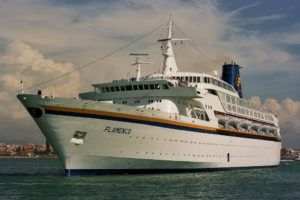
In 1997, Festival Cruises acquired the ship and renamed her Flamenco. When Festival Cruises collapsed in 2004, she was sold for $12.25 million to Cruise Elysia, who renamed her New Flamenco. Club Cruise acquired the ship in 2007 and changed the ship into a floating hotel in New Caledonia until they failed in 2008. The vessel was sold for scrap after a year of layup in Singapore, however in 2012, she was saved from the scrapyard by Ocean Deluxe Cruises and renamed Ocean Dream with a dragon painted on her bow. In 2016, the ship capsized and sank in the shallow waters off the short of Thailand. An attempt to upright the ship failed, and the scrapping of the remnants began in 2017.
MS Mistral
(1999-present, 1999-2004 with Festival Cruises, 48,200 GT, 1,727 Passengers & 670 Crew)
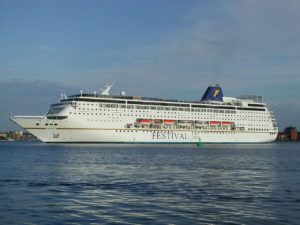
Originally ordered by Renaissance Cruises in 1996, the design and order of the ship was taken over by Festival Cruises marking their first new-build vessel. They opted to charter the ship for the first 12 years with the option to purchase it after the first six years. She sailed her maiden voyage as Mistral from Genoa to the Greek islands. After her inaugural season, she was deployed to Guadeloupe in the Caribbean and then shifted to sail out of Cuba.
In 2004, Mistral was sold off during the bankruptcy of Festival Cruises to Iberojet at auction and was renamed Grand Mistral in 2005. She sailed with Ibero Cruises until 2013, when she was transferred to Costa Cruises and renamed Costa neoRiviera. Costa invested 10 million Euros in the ship to integrate it into its fleet. She would be based out of Dubai for her debut season.
Costa neoRiviera was sent to dry dock in 2019 for a $55 million transformation to shift over to the AIDA brand. After being giving a new appearance, her name changed to AIDAmira and she joined the “AIDA Selection” program, featuring smaller ships that serve exotic calls on longer itineraries.
MS European Vision
(2001-present, 2001-2004 with Festival Cruises, 65,542 GT, 2,679 Passengers & 721 Crew)
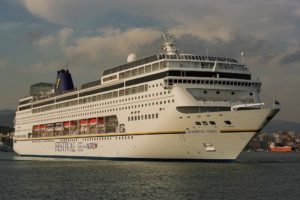
In 2001, Festival Cruises put a new ship into service, the custom-built MS European Vision. Weighing in at just over 58,000 GT and a passenger capacity of 2,087 at launch, the ship participated in the 27th G8 summit in Genoa acting as a secure location to house world leaders in an effort to thwart acts of terrorism should they happen. European Vision sailed with Festival Cruises up until their demise in 2004. MSC added the ship to their fleet in 2004, following the introduction of the Lirica-class and renamed her MSC Armonia. In 2014, for her 10th birthday with MSC Cruises, they modified the ship increasing her weight to 65,542 GT and increasing the capacity by almost 600 passengers. Currently, she sails out of Miami and is part of 3 other sister ships in the Lirica-class with MSC Cruises.
MS Caribe
(1948-present, 2002-2004 with Festival Cruises, 15,614 GT, 556 Passengers)
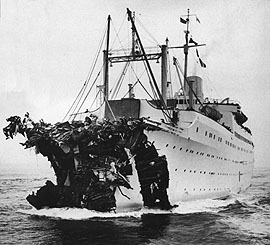
Designs were submitted for the building of a brand new ship to be called Stockholm for the Swedish America Line in 1944. Construction began in 1946 on the new vessel and she made her maiden voyage from Gothenburg to New York in 1948. She was launched with a weight of 12,165 GT and the ability to carry 395 passengers and up to 3,000 tons of cargo. In 1956 there was a significant collision with another ship, the Andrea Doria of Italian Line, in the North Atlantic Ocean off the coast of Nantucket. Although the Stockholm didn’t have any casualties onboard, they did assist the Andrea Doria with their passengers and crew (which experienced 46 fatalities) and continued the voyage with a damaged bow to New York. The repairs took three months and one million dollars to complete. The Stockholm continued to do transatlantic crossings with Swedish America Line until 1959.
In 1960, the ship received a new name, Volkerfreundschaft (“friendship between nations”) and operated under the Deutsche Seereederei (German Shipping Company), a precursor to AIDA Cruises. She made her maiden voyage in 1960 and was home-ported in Rostock, Germany (part of communist Germany) with itineraries sailing to Cuba and other communist countries.
By 1985 the ship was transferred to a Panamanian company with her name reduced to Volker. She didn’t end up sailing with passengers and was laid up in Southampton, England to receive another new name, Fridtjof Nansen and acted as a barracks ship in Oslo for asylum seekers in Norway. In 1989, she was officially sold to Italian Star Lauro Lines with intentions to convert the liner into a luxury cruise ship. She was brought to a shipyard in Genoa, Italy for the transformation to take place, with her interior getting completely gutted and rebuilt from the promenade deck up. Her super structure was extended forward, the aft decks were built up and she gained a more modern cruise ship profile and her weight increased to 15,614 GT.
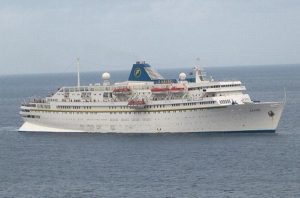
Following the completion of a refit in 1994, she received several changes to her name including Italia I, Italia Prima, and finally Valtur Prima with sailings primarily to Cuba. In 2002, she got a new name, Caribe, and operated with Festival Cruises continuing to sail from Cuba. Following the demise of Festival, she was purchased by Classic International Cruises and renamed Athena where she continued to sail until 2013 when she was bought by Portuscale Cruises and renamed Azores. She was sent to a shipyard in Marseille for a drydock refit and set sail by 2014 with a cruise from Lisbon, Portugal to Bremerhaven, Germany and ended in Genoa, Italy. By 2015 she had entered service with Cruise & Maritime Voyages, setting sail to the Caribbean.
Her last transfer saw the eventual name change to Astoria in 2016 with a charter to French tour operator Rivages Du Monde. It was later announced that she would begin sailing the Sea of Cortez in the winter months from the port of Puerto Penasco beginning in December 2019. After unexpected delays in dry dock, the sailings were pushed back until January 2020 with the 2020 season intending to be the final sailing season for Astoria in the CMV fleet. Cruise & Maritime Voyages entered administration in 2020 and the ship has since been laid up in Tilbury, England.
MV Astoria is the oldest passenger liner still sailing in deep water routes at the young age of 72 years old.
MS European Stars
(2002-present, 2002-2004 with Festival Cruises, 65,542 GT, 2,679 Passengers & 721 Crew)
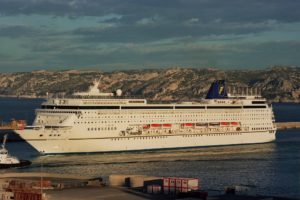
Launched in 2002, European Stars was a sister ship to the European Vision. These sisters shared the same platform as the 1999 Mistral, but with an extended midsection providing for more passenger spaces and an additional deck with cabins that have private balconies. She entered service for Festival Cruises on an inaugural sailing from Barcelona. When Festival Cruises went bankrupt, European Stars was laid up in Barcelona for several months until MSC Cruises purchased her for 200 million Euros. She was renamed to MSC Sinfonia and began sailing in 2005.
During a 10-week refit in 2015, MSC Sinfonia received a 79-foot extension to the middle of the ship. This expansion added 193 cabins and weighed in at 2,400 tons.
Conclusion
Festival Cruises met their demise in 2004 due to the three new ships they were making payments on. The demand to sail with them wasn’t where it should have been since they didn’t have the largest ships or most innovations onboard. There were options for P&O to acquire the line as was attempted in 2000, however P&O backed out due to the low value of cruise shares at that time. In 2004, Royal Caribbean was looking into the option of buying the failed line, however the ships were seized by the owners of the shipyard that built the Mistral, European Vision and European Stars due to the failed contractual financial obligations.
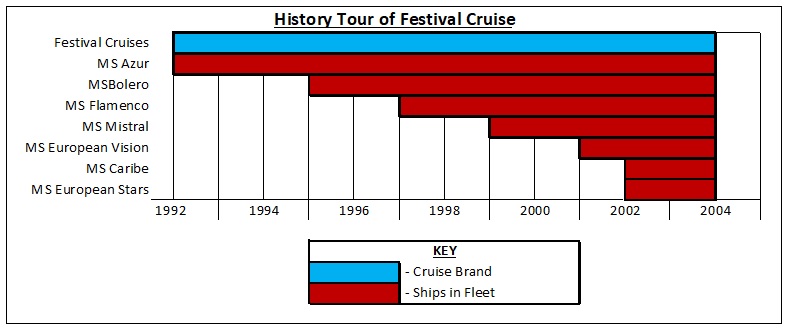
Have you sailed on one of the Festival Cruises ships, whether under that name or one of the many other names that their ships have taken on? While the brand was around for a mere 10 years, they certainly had a strong fleet of ships with many still operating today!
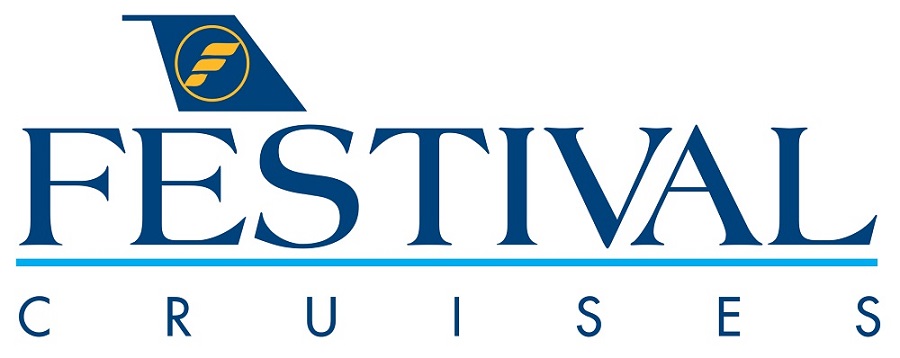
I worked on Festival from 98 till the end of 2002. On the Flamenco, Bolero, Azur, and European Vision. They were great ships to work on and I took away a lovely souvenir – my husband, who was the DJ on the European Vision when we met.
Rachel, thank you so much for sharing your experience with us. It’s great that you had such a wonderful time working for the line and what an awesome take-away to have met your lifelong partner. Hopefully our article brought back some great memories for you!
I knew of European Vision, saw her berthed at Barbados and hadn’t thought much of it until evening. I was aboard QM2 on her maiden 14 night voyage from Southampton and as we departed the port, across the way that January, 2004 night, European Vision was a forlorn, strikingly eerie sight without any discernible lighting. She remained in layup there until after having been sold to MSC that spring. As of 2023 she remains with that line as Armonia.
Wow! Thank you for sharing those details. It really is quite interesting to see how these older ships are treated. Always nice when they’re given a second life, we just hope that the ship is well respected by the MSC brand!